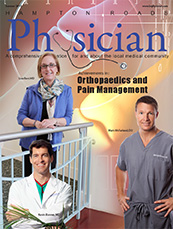View Summer 2013 issue Click Here
For Ipad & Iphone Click Here
The Ever Evolving World
of Orthopaedics and Pain Management
By Bobbie Fisher
Twenty-first century scholars can only guess the real identity of the first physician, although ancient scrolls suggest that Imhotep, an Egyptian who lived around 2650 BCE, was the first medical doctor known by name. Among Imhotep’s contributions to medicine was a textbook on the treatment of wounds, tumors and broken bones – suggesting he might qualify as the first orthopaedist as well. Certainly we know that Egyptian practitioners dealt with orthopaedic cases: Egyptologists have found mummies with splints made of bamboo, reeds, wood or bark, padded with linen.
Hippocrates, who was born in 460 BCE, wrote detailed instructions for the treatment of dislocations of the shoulders, knees, and hips, as well as treatments for infections resulting from compound fractures. He is noted for saying that war is the only proper school for surgeons, and indeed, it is well established that much of what has been learned about musculoskeletal care was the result of caring for soldiers on the battlefield.
Galen himself, who practiced during the rise of Rome despite his Greek heritage, was a gladiatorial surgeon. He studied the skeleton extensively, as well as its surrounding muscles, and there are accounts from his era of wooden legs, iron hands and artificial feet.
 On the battlefields of the Middle Ages, the injured were treated with bandages soaked in horses’ blood, which dried to form a stiff splint. The years – and the wars in between – produced remarkable innovations: the American Civil War introduced a host of orthopaedic and surgical advances. Even though the dire consequences of bacteria and infection were not realized until after the war’s end, many modern medical practices originated on the battlefields and in the hospitals, including the use of pulleys and weights to realign lower extremity fractures. Traction and splinting were developed during World War I. Since WWII, treatments have evolved to include joint replacements, arthroscopy, and a whole host of technologies. It remains to be revealed the myriad of developments that will come from the efforts of orthopaedists and pain specialists treating the soldiers fighting the wars in Iraq and Afghanistan.
On the battlefields of the Middle Ages, the injured were treated with bandages soaked in horses’ blood, which dried to form a stiff splint. The years – and the wars in between – produced remarkable innovations: the American Civil War introduced a host of orthopaedic and surgical advances. Even though the dire consequences of bacteria and infection were not realized until after the war’s end, many modern medical practices originated on the battlefields and in the hospitals, including the use of pulleys and weights to realign lower extremity fractures. Traction and splinting were developed during World War I. Since WWII, treatments have evolved to include joint replacements, arthroscopy, and a whole host of technologies. It remains to be revealed the myriad of developments that will come from the efforts of orthopaedists and pain specialists treating the soldiers fighting the wars in Iraq and Afghanistan.
Throughout this history, physicians and healers have employed a multitude of remedies to relieve the pain associated with musculoskeletal injury and disease. Early theories of pain included the presence of evil spirits, an imbalance of bodily fluids, or simply punishment by whichever gods had been angered. Archeologists have discovered evidence of opium use to relieve pain as early as 5,000 BCE. Later, everything from herbal remedies, placing electric eels on a wound, or even sacrifices of goats and other livestock was used to manage pain.
Today’s patients have centuries of soldiers, surgeons and healers to thank for the excellent, minimally invasive and innovative care that is available to those who suffer musculoskeletal injury and pain.
And those who suffer today are many: the American Academy of Orthopaedic Surgeons notes that musculoskeletal disorders and diseases are the leading cause of disability in the United States. Also according to the AAOS, in 2012, there were 27,773 orthopaedists to take care of them, or 8.72 per 100,000 patients – while the American Academy of Physical Medicine and Rehabilitation includes in its membership more than 8,000 physicians and physiatrists Board-certified to treat musculoskeletal pain.
The physicians spotlighted in this issue of Hampton Roads Physician focus on three distinct areas: orthopaedists Dr. Kevin Bonner with sports medicine and arthroscopic surgery and Dr. Mark McFarland with spine and joint replacement surgeries, and Dr. Lisa Barr with patients suffering musculoskeletal pain of every etiology.
In addition to our cover doctors, you can read about the innovative accomplishments of many of their colleagues in our In the News column on page 31. Extraordinary work is being done every day in the fields of orthopaedics and pain management, and a great deal of it is being done in this community, by world-class practitioners who call Hampton Roads home. It is our privilege to showcase these dedicated physicians.


